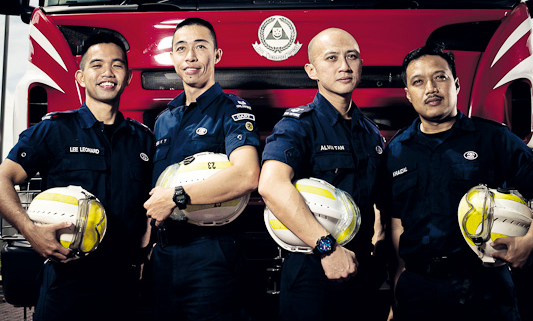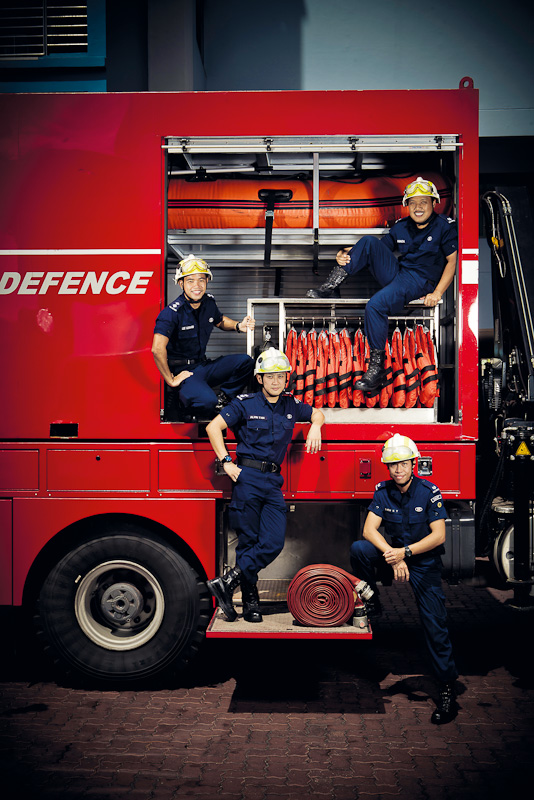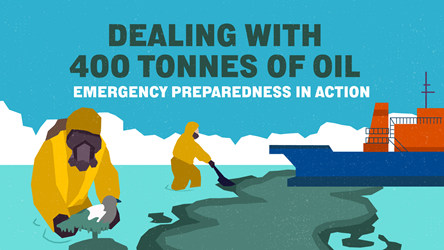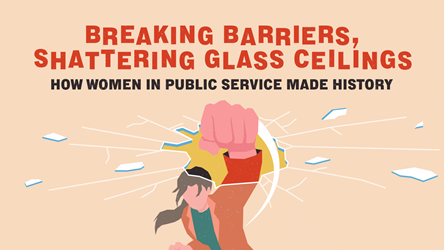Meet the Transformers

Multi-taskers to the Rescue
It was at a monthly operations meeting in February 2010 when four Civil Defence officers from different divisions shared the problems they had encountered on the ground. They wanted to enhance SCDF’s water rescue capacity during flood rescues and show how fire-fighters could tap large amounts of water to put out large-scale vegetation fires and industrial blazes.
The four men (above) knew a solution was needed, but there was no luxury of money to build specialised vehicles for each problem. They had to find creative ways to deal with floods, vegetation fires or warehouse blazes with limited resources.
Team leader LTC Tan encouraged everyone to “look beyond typical fire engines… and instead take a look outside and watch movies to get ideas”. They did just that. Inspired by the movie Transformers, they spent a month toying with the idea of “transforming” vehicles before agreeing on what they wanted.
The result: the Multi-Utility Vehicle or MUV, a four-wheel drive truck with a crane and hydraulic tailgate that can load up and switch between three operational modules onto its chassis.

The Flood Response Module has an amphibious vehicle, water rescue items and two boats that can carry up to six persons each. The Water Supply Module has hoses that can lay up to four kilometres, while floating pumps allow it to tap open sources like the sea, river or reservoirs. The Vegetation Fire Module has two water tanks with 3,000-litre capacity each and two pumps that can generate water jets to extinguish deep-seated vegetation fires.
It was not easy coming up with the MUV as “one of the challenges was to convince the senior management to approve this idea” shared LTC Tan. The bosses had to be convinced that “the MUV need not be as fast as the fire engine” as it takes time to change between modules. With limited budget for specialised vehicles, the MUV was their best bet.
The team also had to think about how operations would be carried out. Who should operate the MUVs? And where should they be based?
But the key lesson for LTC Tan was learning how to back up good ideas. “Many officers don’t dare to go beyond their boundaries. I strongly believe that if you want to do certain things like selling your idea to senior management, you need to be bold enough to put that idea out front and not do it blindly, but to really gather a lot of facts, research and feedback,” he said.
By being creative and tenacious, the team was able to push their best ideas forward and transform their vision into reality.
Mangrove Rescuers

Pulau Tekong is home to the largest patch of mangrove in Singapore. It is also where many rare species of flora and fauna – absent in mangrove on the mainland – are found.
But in 2006, the National Parks Board (NParks) found that heavy boat traffic and strong waves were toppling mangrove trees along the island’s north-eastern coast. The 92 hectares of pristine mangrove were being rapidly eroded at one hectare a year.
This prompted NParks to set up a multi-agency team (including the Housing and Development Board and the Ministry of Defence, among others) to rescue the mangrove. From the outset, hard engineering methods such as building seawalls that merely deflect the waves elsewhere were a no-no.

therefore [the] key thing that we stuck to was that [the solution] must be environmentally sustainable and it must minimise the impact to the environment,” said team leader Dr Lena Chan, Deputy Director of the National Biodiversity Centre (NBC) which comes under NParks.
Initially, the team thought they could backfill the eroded shoreline with mud and plant mangroves on top. They took a scientific approach and experimented before calling for a tender. But the trial that consisted of planting mangrove in biodegradable bags on mud failed.
“The consultants were very nervous,” recounted Ms Yang Shufen, Head of Park Planning at the NBC. “There was an email saying ‘Oh my goodness, the bags spilled’. They sent us photos of mud spilling out from the bags.” The periodic strong winds in the area had ripped the plants apart, forcing the team to rethink their approach.
In the end, they decided to combine soft and hard engineering by building a rock revertment and growing mangrove in between the gaps. Biodegradable planter rings would protect the saplings till they were stronger while bakau poles were placed in front of the revertment to deflect strong waves.
The ambitious rehabilitation plan was a first in the world. No one had any prior experience so everyone, including contractors and consultants, had to innovate and adjust plans as they learnt more about the environment they operated in.
Ms Yang recalled how a local company that produces biodegradable planter bags was tasked to make bags that would degrade in four months so the mangrove saplings’ growth would not be inhibited. This led to the invention of bags that degraded according to clients’ specifications. Such innovations, she pointed out, have the potential to be marketed locally and globally.
The team openly admits that their plans were never set in stone. “When building with nature, it is dynamic. You have to do some small experimentation on a pilot plot, refine it, and then do it again and so on,” said Mr Lim Liang Jim, Assistant Director (Coastal and Marine Environment) at NBC.
So, before starting on the official 1.9km shoreline rehabilitation, the understandably nervous consultants suggested trying out a 50m pilot site first. It was half successful – with some plants dying. The team quickly studied the mangrove species that thrived (they planted 14 types) and tweaked their plans quickly to boost survival rates. They were learning at every turn.
But while the team fretted over various aspects of the project like the health of the saplings or pull of the tides, they worried less about failure.
“People are so afraid of failure. There is so much fear, so they go for the easy conventional methods,” said Dr Chan. By rejecting convention, the team knew they had to invest more time on trials and take on more risks. This was encouraged by a culture of “flexibility and forgiveness”.
“It’s the willingness to speak up and go back to my bosses and say ‘it failed’,” said Ms Yang. “You must be comfortable to feel that if your little experiment failed, you won’t be ‘killed’. If a trial fails, it’s a good thing because you will learn.” After nearly a year, there are positive signs, such as the natural propagation of mangrove plants amidst the revertment. But the team says it is too soon to call it a success as a much longer period of monitoring is required. But if successful, this innovative Singaporean method of rescuing mangroves could well become the gold standard globally.

- POSTED ON
Jan 5, 2012
- TEXT BY
Nazurah Sa’ad
- PHOTOS BY
photos of SCDF by John Heng









